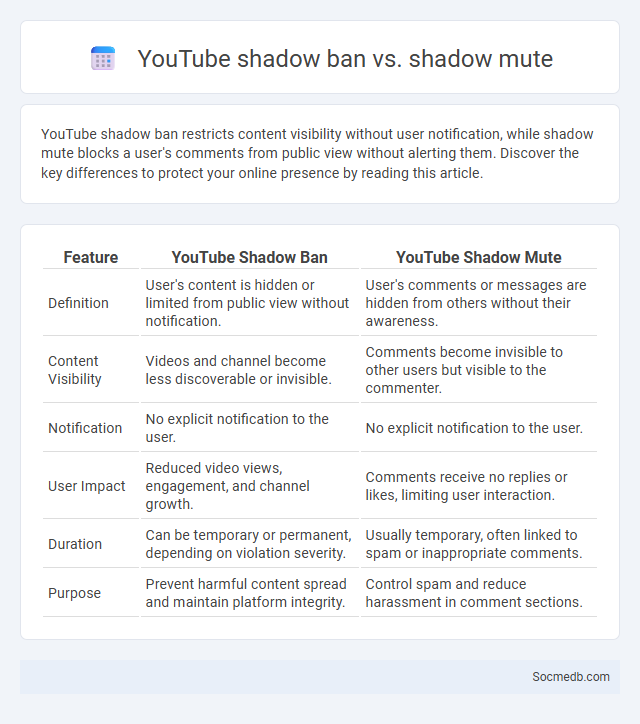
Photo illustration: YouTube shadow ban vs shadow mute
YouTube shadow ban restricts content visibility without user notification, while shadow mute blocks a user's comments from public view without alerting them. Discover the key differences to protect your online presence by reading this article.
Table of Comparison
| Feature | YouTube Shadow Ban | YouTube Shadow Mute |
|---|---|---|
| Definition | User's content is hidden or limited from public view without notification. | User's comments or messages are hidden from others without their awareness. |
| Content Visibility | Videos and channel become less discoverable or invisible. | Comments become invisible to other users but visible to the commenter. |
| Notification | No explicit notification to the user. | No explicit notification to the user. |
| User Impact | Reduced video views, engagement, and channel growth. | Comments receive no replies or likes, limiting user interaction. |
| Duration | Can be temporary or permanent, depending on violation severity. | Usually temporary, often linked to spam or inappropriate comments. |
| Purpose | Prevent harmful content spread and maintain platform integrity. | Control spam and reduce harassment in comment sections. |
Understanding the Concept of Shadow Banning
Shadow banning refers to the practice of covertly restricting a user's visibility on social media platforms without their knowledge, effectively limiting their reach and engagement. This technique is often used to curb spam, misinformation, or disruptive behavior while avoiding direct confrontation or public backlash. Understanding shadow banning involves recognizing its impact on account activity, such as decreased interaction and limited appearance in searches or feeds, despite normal posting behavior.
What is a YouTube Shadow Ban?
A YouTube shadow ban occurs when your content becomes less visible or hidden from search results, recommendations, and subscriber feeds without explicit notification. This reduction in visibility can severely impact your channel's growth and audience engagement by limiting the reach of your videos. Understanding YouTube's algorithms and community guidelines can help you avoid behaviors that trigger shadow bans and protect your channel's performance.
Exploring Shadow Muting on YouTube
Exploring Shadow Muting on YouTube reveals how this feature allows users to discreetly hide comments or interactions without the other party knowing, enhancing your control over community engagement. This subtle moderation tool improves your channel's environment by reducing spam and toxic behavior while maintaining open communication. YouTube's algorithm favors healthier interactions, making shadow muting a valuable strategy for sustainable audience growth.
Key Differences: Shadow Ban vs. Shadow Mute
Shadow ban restricts a user's content visibility without notification, limiting audience reach and engagement on platforms like Instagram and Twitter. Shadow mute hides a user's comments or posts from others while allowing the muted user to interact normally, often used to manage disruptive behavior without confrontation. Both techniques aim to regulate online interactions but differ in transparency and user awareness.
How Shadow Banning Works on YouTube
Shadow banning on YouTube involves limiting the visibility of a user's content without notification, making videos less likely to appear in search results, recommendations, and subscriber feeds. YouTube's algorithms detect violations of community guidelines or spam-like behavior, triggering reduced distribution to minimize the spread of questionable content. Creators often experience significant drops in engagement metrics without clear explanations, reflecting the platform's covert enforcement strategy to maintain content quality and user experience.
Common Signs of Being Shadow Banned
Shadow banning on social media platforms often results in a sudden drop in your post engagement, such as likes, comments, and shares. You might notice your content not appearing in hashtag searches or followers' feeds, significantly reducing visibility. Monitoring these common signs helps you identify and address shadow bans to maintain your online presence effectively.
Why Does YouTube Shadow Ban Users?
YouTube shadow bans users primarily to enforce community guidelines and prevent harmful content without direct confrontation, reducing visibility of videos or channels that spread misinformation, spam, or violate platform policies. This form of subtle moderation helps maintain a safe environment by limiting the reach of content that disrupts the platform's integrity while avoiding explicit penalties that might escalate conflicts. Users experiencing shadow bans often see significant drops in video views, engagement rates, and discoverability within YouTube's recommendation algorithms.
Shadow Banning vs. Traditional Banning
Shadow banning restricts your content visibility without notification, making posts less discoverable through search or hashtags, while traditional banning removes your account entirely or suspends access. Social media platforms employ shadow banning to subtly limit content reach, preserving user engagement and minimizing backlash, whereas traditional banning enforces stricter penalties for policy violations. Understanding these differences is crucial for maintaining your online presence and adapting content strategies effectively.
Preventing and Recovering from Shadow Bans
Shadow bans on social media platforms can severely limit your content's visibility without your knowledge, impacting engagement and growth. To prevent shadow bans, consistently follow community guidelines, avoid excessive hashtag use, and engage authentically with your audience. If you suspect a shadow ban, reviewing platform policies, reducing spam-like activities, and appealing to support teams are key steps for recovery.
Impact of Shadow Banning on Content Creators
Shadow banning significantly reduces the visibility of content creators by limiting their reach without notification, causing engagement rates to plummet. This covert restriction disrupts audience growth, revenue streams, and brand collaborations, often leading to decreased motivation and increased frustration among creators. Platforms' opaque enforcement policies exacerbate confusion, hindering creators' ability to adjust their strategies effectively.
 socmedb.com
socmedb.com